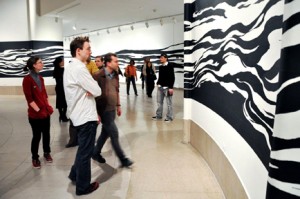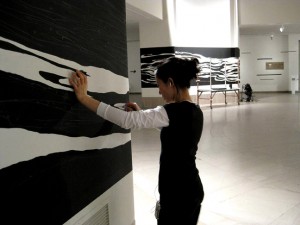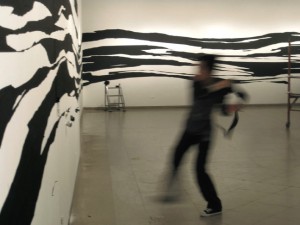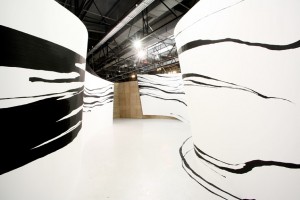« Features
Sun K. Kwak: Enfolding 280 Hours

Sun K. Kwak. Enfolding 280 Hours, 2009. Installation view at Brooklyn Museum. Photo Zake Kim. Courtesy of the artist and Ch’i Contemporary Fine Art
By Ernesto Menéndez-Conde
“My drawings are born through the communion between the material and the spiritual, wherein my own self is constantly reflected emptying itself.” Sun K. Kwak, 2007
Many scholars are seeing Postmodernism as a moment that already belongs to the past. They have suggested that we are entering a qualitatively different type of cultural production, in which participation of the viewer in the space, and site-specific artworks are playing a main role. In his essay, “The Topology of Contemporary Art,” the art critic Boris Groys insists on the importance of the context in recent creations:
“What differentiates contemporary art from previous times is only the fact that the originality of a work in our time is not established depending on its own form but through its inclusion in a certain context, in a certain installation, through its topological inscription.” [1]
In that sense, as a topological inscription, the space of the museum is becoming an increasingly important artistic medium. Creators are integrating the physical, architectural specificities of art institutions into artworks. Walls, glass doors, and floors tend to be transformed and appropriated by the artist.

Sun K. Kwak. Enfolding 280 Hours, 2009. Work process. Photo Robert Nardi. Courtesy of the artist and Ch’i Contemporary Fine Art
This is the case of the installation Enfolding 280 Hours, by the Korean-born artist Sun K. Kwak, which is currently on the fifth floor of the Brooklyn Museum (the exhibition will be open until July 5th). Kwak’s work consists of sticking masking tape to the walls. She adapted her installation to the architectonic forms, including the four pillars, and the glass doors of the place. She creates several wide, horizontal, uninterrupted stripes of black, against the white surface of the background. Inside the stripes there are inner lines, and suggestive rhythms that could evoke an elementary, strongly intuitive world (I indistinctly associated rhythms with ocean waves, tree bark, and movements of flames). These long stripes - the artist used three miles of masking tape for completing her installation - provide fluid undulations that unify the space.
In its most basic overview, the installation exploits the figure of the square inside the circular form, which characterizes the hall on the fifth floor of the Brooklyn Museum. Enfolding 280 Hours is, therefore, a well-defined structure. The artist carefully calculates where to “draw” the lines, and how they will be driven on surfaces. However, there is a broad margin for spontaneity and controlled randomness. The edges of the lines are irregular, shaped by the accidental way in which Kwak’s hands ripped the masking tape. Kwak’s installation can be related to abstract expressionism, since the lines she makes are strongly expressive gestures. Besides, the homogeneous treatment of the whole piece could recall the notion of all-over painting, which was one of the most recognizable features of post-war American abstraction.

Sun K. Kwak. Enfolding 280 Hours, 2009. Work process. Photo Robert Nardi. Courtesy of the artist and Ch’i Contemporary Fine Art
The title of the installation alludes to the process of placing the masking tape on the walls. Two hundred eighty hours was approximately the amount of time that Kwak invested in completing the artwork. This reference to the action somehow invites us to visualize the technique, and the handcrafting done by the artist. Actually viewers also had the opportunity of visiting the work in progress, and enjoying the performative side of the installation.
Since the late nineteenth century, one of the most common misconceptions about new art has been the belief that it breaks with tradition and tends to hide a lack of technical skill. The notion that an artwork does not demand any particular gift, craft or technical training has been part of the profane critique against artistic productions which stay away from realism and academia. This criterion is far from being accurate, although it might apply to certain artistic practices. Whereas skills related to traditional techniques of painting and sculpting have been fading away and are no longer prevalent, there has been a remarkable proliferation of new artistic procedures, methodologies and materials. Beyond painting, and sculpture - understood in the traditional sense - artists have been exploring and inventing a wide variety of techniques, which demand very particular, sometimes sophisticated skills. Kwak is one of these artists who has found very imaginative means of expression, which also involve resorting to highly personalized techniques. Needless to say that enfolding masking tape on a wall is an unconventional, creative, way of conceiving, and doing art. But it is a technique that produces very peculiar expressive qualities. Kwak is working with a new way of inserting abstract art into space, with new textures and visual properties. She sees her installations as “space drawing.” They are drawings because her installations are essentially about lines, their continuous flow, shapes, and tonal contrasts. However, unlike the two-dimensional supports traditionally associated with drawing, hers are developed in space, surrounding spectators and immersing them in an environment of lines. In other installations, Kwak has prolonged her “space drawings” to the floors, the ceilings, and even the stairs of the places. Following the trajectory of these traces in the space is perhaps the main (and maybe the most rewarding) visual adventure in Kwak’s installations. It is worth walking through the hall, enjoying the shifting of the lines, staying as close as possible to the surfaces covered with masking tape, and paying attention to the small irregularities and entanglements of lines. But the viewer is also compelled to contemplate the lineal undulations from a distance, seeing how they become thinner, or wider, how they travel through the space, as if they were musical phrases that show up and participate in the harmony of the whole.

Sun. K. Kwak. Untying Space Gwangju Biennale, 2006. Photo Youngha Cho. Courtesy of the artist and Ch’i Contemporary Fine Art
In Enfolding 280 Hours, Kwak not only attempts to expose the performative, technical dimension of her artwork, but she also tries to experience time as a stream of consciousness/unconsciousness through which she tries to achieve a meditative, beyond words, openness to the present. The flow of time is also suggested through rhythms. In this particular installation, Kwak intends to construct visual analogies with ¾ beats, which is a way of structuring tempo in many musical compositions. Through rhythms, she plays with the unification of the positive and the negative. In Enfolding 280 Hours, the movement of lines located on the walls follows a clockwise direction, whereas the lines on the pillars are spinning in the opposite direction. This contradictory use of rhythm suggests an opposition between the pillars and the walls, the positive (in which the stripes have irregular edges, opened to the background), and the negative (which is a closure against the white walls). But it is a dialectical opposition, since contraries complement each other and, and seen from the distance they produce an effect of transference and continuity. As the artist wrote to me in an email, “these two different directions of lines spin together and they gradually tighten the space as a whole.”
This dialectical conception of the artwork seems to be an essential component of the artist’s notion of “space drawing.” Enfolding 280 Hours, like many other of Kwak’s installations, could be explained through a set of visual oppositions: the three-dimensional emptiness of the space versus the flatness of architectonical forms, the black masking tape against the white surfaces, the small accidents, and textures (which must be perceived very closely) against the structural set of lines that should be seen from a distance. But there are also oppositions between the sensual and the meditative, consciousness and the intuitive, time versus space.
Enfolding 280 Hours is an ephemeral artwork. It will disappear right after the final day of the show. With its performative side, the installation mimics a vital cycle (from its early stages, to its plenitude, and its disappearance). After that, there will be pictures, videos, written texts, and a few other documents (like, perhaps, some remnants of the masking tape she used). These materials, however, cannot grasp the viewer’s experience of actually being there, or being immersed in the inner, auratic space of Kwak’s installation. The artist attempted to establish an intense dialogue with the viewer by calling on visual elements. But it is a communication that demands being in the installation, participating in the “space drawing,” and experiencing the expressiveness of the lines. In Groys’ essay, which I quoted earlier, the author claims that an installation creates an enclosure, and by doing so, it also creates an outside. This enclosure is related to a “reauratization” which - contrary to Walter Benjamin’s idea of the “loss of aura” - seems to emerge in contemporary art. Groys argues that the space of the installation shows objects and images as true beings [2]. In Enfolding 280 Hours emptiness becomes, using Groys’ term (which he took from Heidegger), unconcealed and is taken to the realm of the visible. Kwak has created a sort of “magnetic field” that turns her installation into a space for meditation, solitude and introspection.
Notes
1- Groys, p. 74
2- Op. cit., p. 80
Bibliography
Buscando la raíz. Historias Coreanas al Desnudo (catalogue), Consejería de Cultura y Deportes, Madrid, 2007, p. 27
Groys, Boris. “The Topology of Contemporary Art”. In Antinomies of Art and Culture. Modernity, Postmodernity, Contemporaneity. Duke University Press, Durham & London, 2008, pp. 71-80.
Oren Yaniv, “Artist Sun Kwak’s abstract installation ‘Enfolding 280 Hours’ transforms Brooklyn Museum with tape” in Daily News, Brooklyn, New York, March18th,2009. (http://www.nydailynews.com/ny_local/brooklyn/2009/03/17/2009-03-17_artist_sun_kwaks_abstract_installation_e.html)
Enfolding 280 Hours is on view at the Brooklyn Museum through July 5, 2009.
Ernesto Menéndez-Conde is finishing a PhD in Romance Languages at Duke University. He has published in magazines in Havana, Spain and New York. He has also collaborated with Marlborough Gallery and Sotheby’s in New York.


































